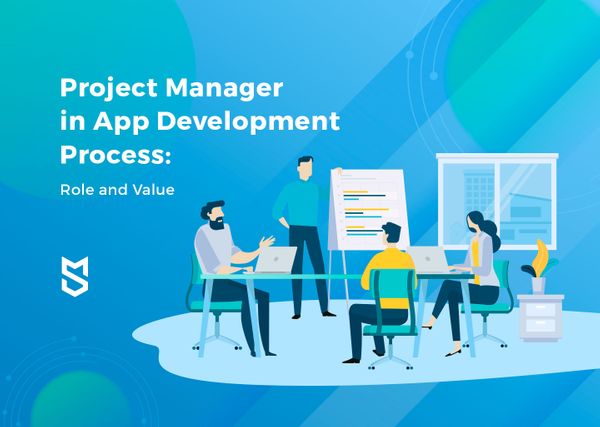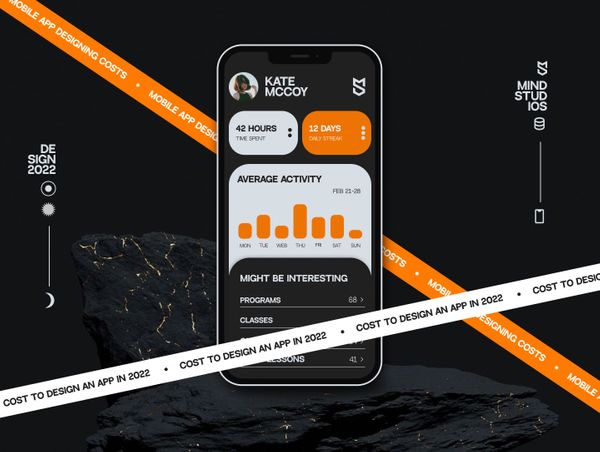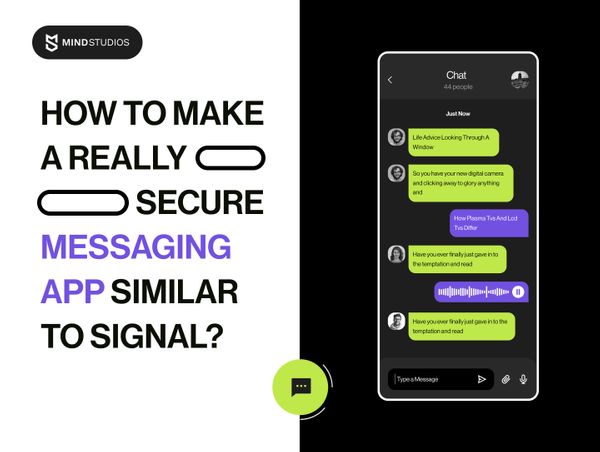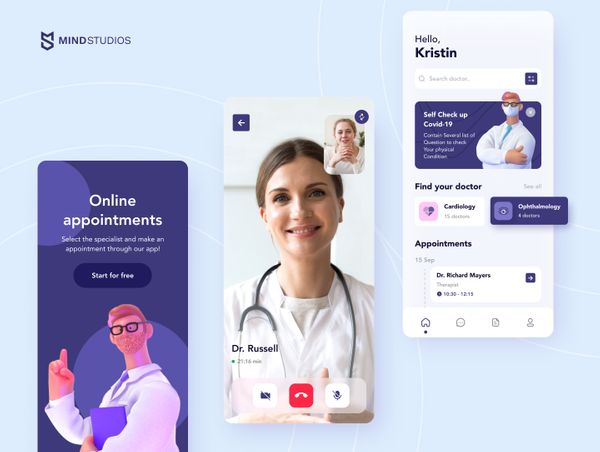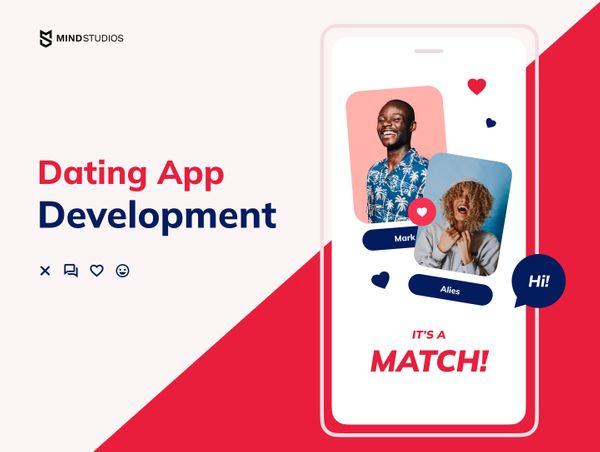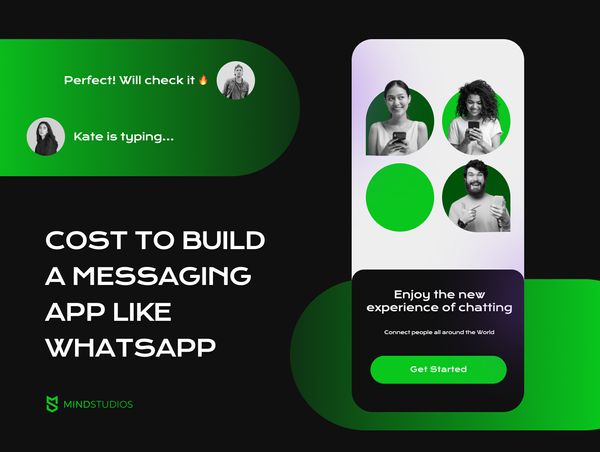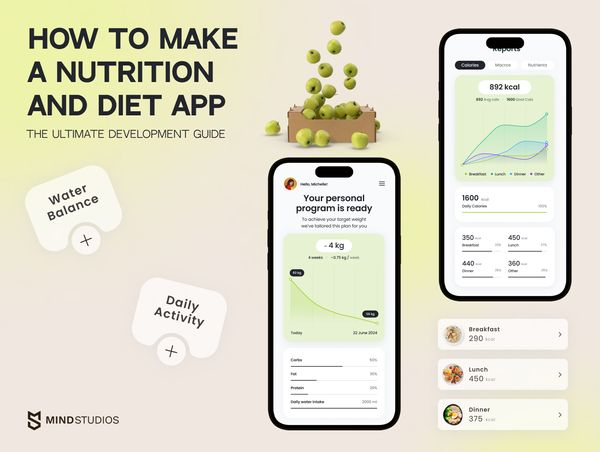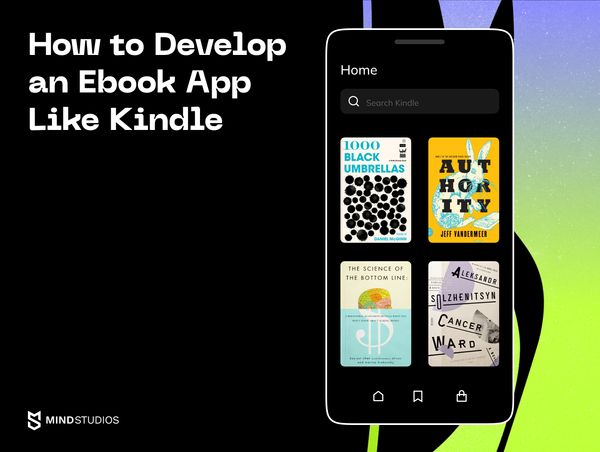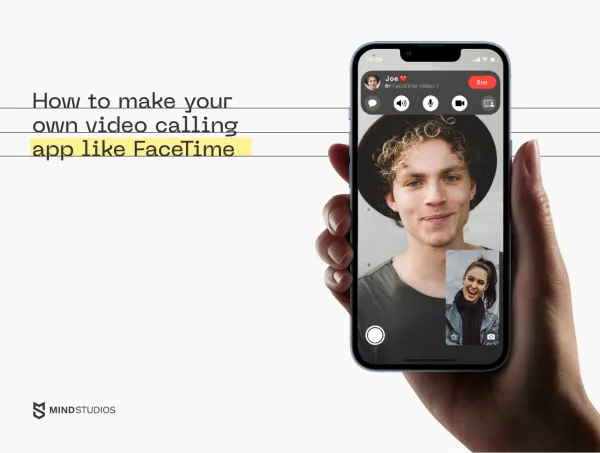
Back in 2020, people from around the globe, forced to stay home because of the pandemic, discovered that video calling can be beneficial not just as a means of connecting with others while social distancing. Easy scheduling, increased productivity, and even money-saving are just a few reasons why apps like Zoom and FaceTime have become essential tools for both business and pleasure.
Now, even though the offices and coworking spaces have reopened, the adoption of hybrid communication and work is rooted too deeply into our everyday lives.
So, what can we learn from the experience of popular video call services that have been on the rise since 2020? How to make your own video calling app like FaceTime — and why should you do it at all? And finally, how much will it cost to build an application of this kind?
In this article, we explore the answers to these questions and share Mind Studios’ experience of working on developing video calling platforms aimed at connecting people.
Video chat apps market growth
It’s hard to underestimate the role COVID-19 played in the rise of video chat platforms. Zoom alone experienced an increase from 10 million daily meeting participants to 350 million throughout 2020. And if you think that after 2020 such platforms experienced a downfall, Microsoft Teams reported having 270 million monthly active users in January 2022, which meant a 20 million rise in just 6 months.
However, even without the pandemic, video chats’ popularity would have continued to grow — even if at a slower pace. After all, in times of globalization, it’s a way of conducting business, studying, connecting with international communities, and simply staying in touch with loved ones scattered around the world.
Now, let’s get into the specifics of how the video chat platforms market looks today — and what it might look like in the near future:
- In 2021, the global video conferencing market was valued at USD 6.28 billion. It is also expected to grow at a CAGR of 12.5% from 2022 to 2030.
- North America has a higher adoption rate of video conferencing technology and therefore, accounted for 39.0% in revenue share in 2021.
- Europe held a market share of 29.8%, which makes it the second region dominating the video conferencing market.
- The Asia Pacific market for video conferencing is expected to witness a CAGR of over 14.0% through 2030.
Why you should build a video calling app
“It’s easy to just put together a call and get face-to-face, making sure customers get their questions and issues addressed. Video personalizes things: They get to know me; I get to know them. That drives better communication, creates trust and builds stronger relationships.”
Tom Keiser, former CIO of customer service software Zendesk. Forbes
If the stats from the previous section haven’t been convincing enough for you, here are just some benefits of video calling platforms that make people from all over the world use them. These are the same perks that persuade entrepreneurs to develop video chat apps of their own — and might encourage you to do the same.
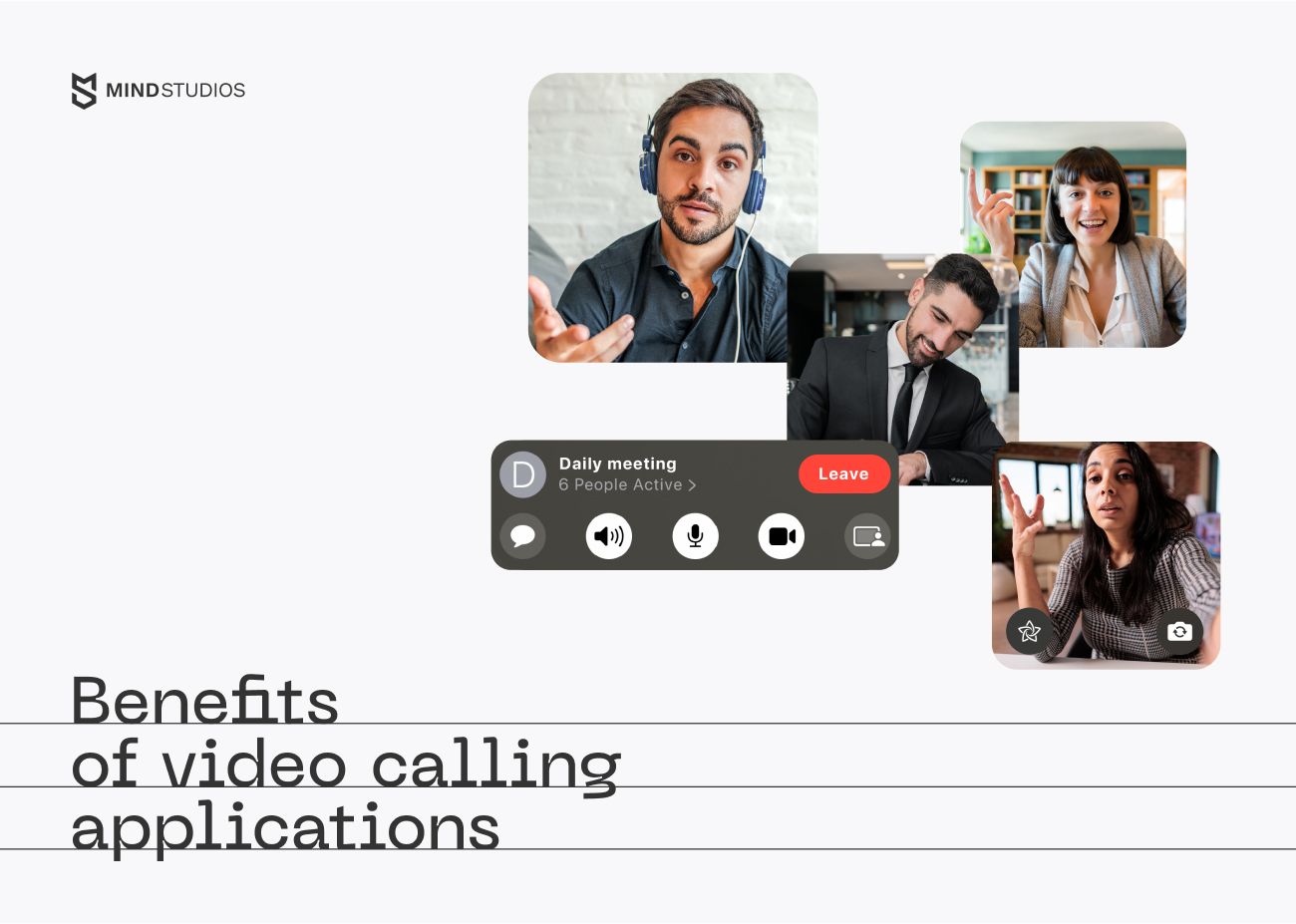
Time and cost optimization for businesses
Video conferencing benefits most departments of various companies. For instance, with video calling tools the sales team can reach a wider client base, while the HR specialists are no longer bound by geographical location when looking for new employees.
Moreover, video conferencing can cut down business trips to a minimum, and that also reduces costs.
What is more, providing employees with an opportunity for a flexible work model (remote or hybrid) influences employee retention. For those employees that can choose between commuting and working from home, it’s easier to maintain a healthy work-life balance while staying close to their teams through video calling. Such workers are generally more content, and that can also save businesses money in the long run.
Increased productivity
It has long been proven that humans process visual information better than text or audio. In one study, researchers came to the following conclusion: “It is clear from these results that auditory recognition memory performance is markedly inferior to visual recognition memory.”
Apart from the fact that visual communication is more effective, up-to-date video call applications offer various tools that are aimed at increasing productivity. These include gamification elements, automized note-taking, and advanced analytics tools that can help analyze how actively engaged the participants are. Also, the option of recording virtual meetings helps preserve all the significant information shared there.
Efficient communication
Text communication for teams is perfectly fine. However, when it comes to talking to clients, video conferencing can help you avoid miscommunication and lead to more satisfying results. After all, intonation and body language are integral parts of communication that can help people build trust and understand each other better.
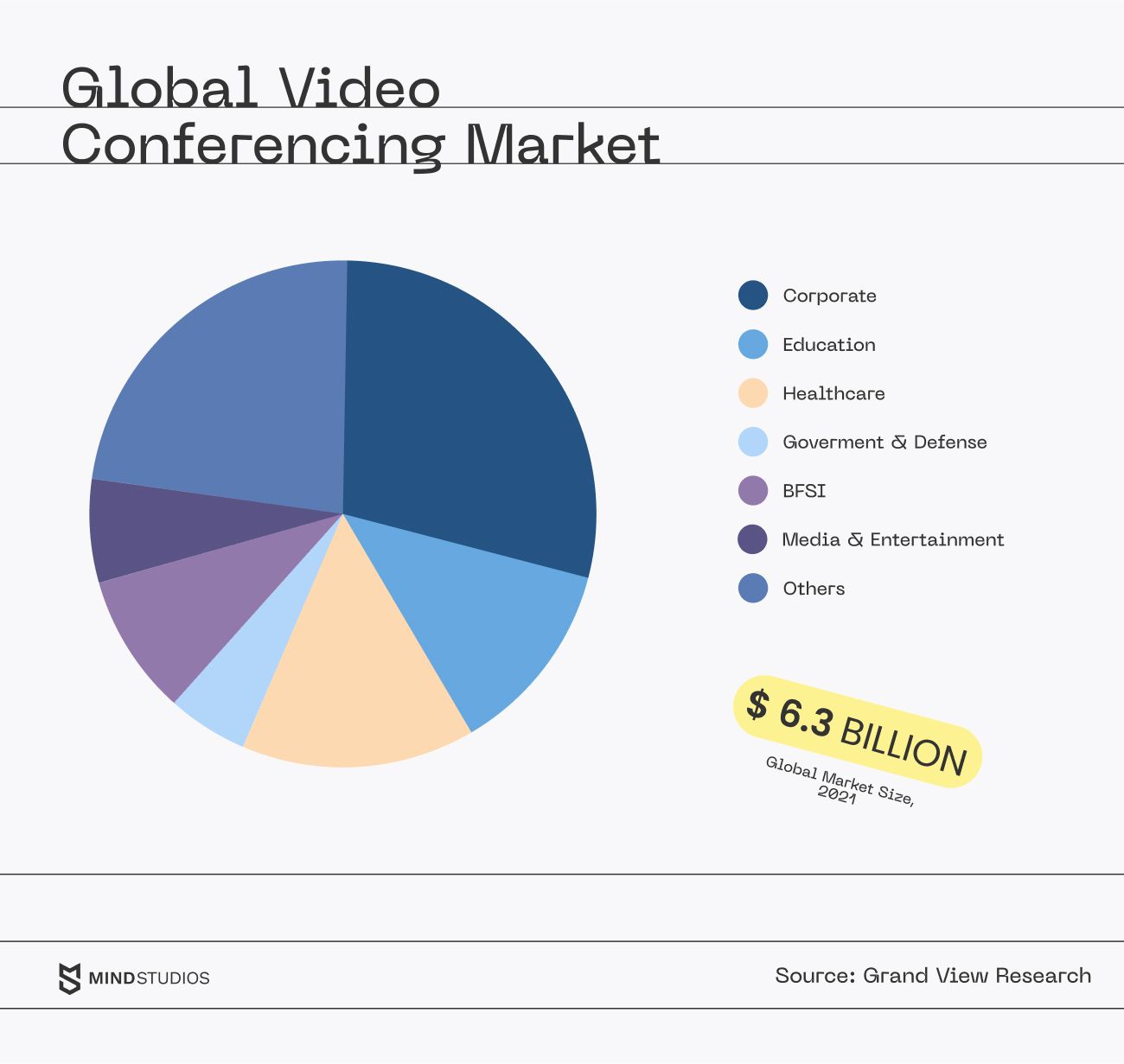
While here we focused mostly on the perks of video conferencing for business in general, there is a list of more specific niches that benefit from video calling functionality greatly:
- Schools and universities
- Healthcare providers that deal with remote consultations
- Organizations that work with highly sensitive information and need a secure
- Video conferencing app specifically for their needs
- FinTech services providing consultations
- E-commerce, especially platforms selling high-value products
- Online dating applications
- Video gaming industry
Core types of video chat apps
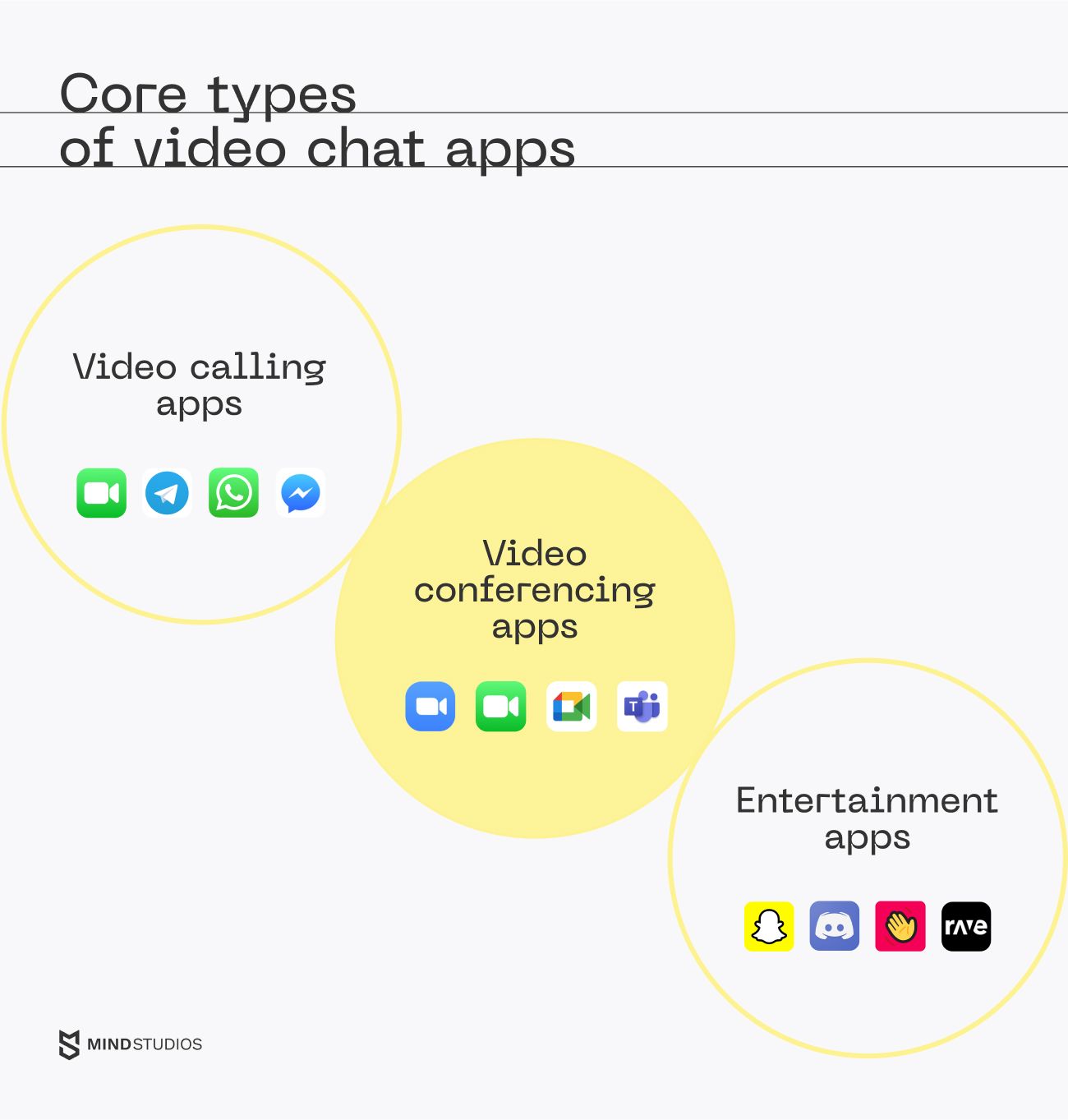
Depending on the main communication purpose of the platforms and the tools they provide, mobile video chat applications can be roughly divided into three categories. Let’s take a look at each of them.
Video calling apps
The video calling function of these apps is usually an additional one, as most of the examples are simple text messengers. As a result, these types of apps are rarely used in business and are mostly suitable for personal communication.
Typically, they allow for one-on-one calls, but some also provide users with an option of a video conference for a small group of people.
Examples: FaceTime, WhatsApp, Facebook Messenger, Telegram.
Video conferencing apps
The primary function of this app type is enabling video communication between groups of people, whether it’s 5, 100, or even several hundred participants. Therefore, it’s often used for work, business, e-learning, online events, etc.
While there are globally known platforms like Skype, professionals in certain industries also develop limited-access conferencing apps. For instance, healthcare providers must use only those applications that are compliant with data protection regulations, and therefore, can’t use Skype.
The main focus of video conferencing apps is providing high-quality video and audio communication, but the functionality is not limited to it.
For instance, among tech trends in the industry are AI and machine learning, which can assist in increasing the productivity of meetings.
Examples: Zoom, FaceTime, Google Meet, Microsoft Teams.
Entertainment apps
Going beyond conversations, entertainment video conferencing apps are created to let users have shared experiences online. With these tools, playing board and video games, watching movies, creating content together, and even partying became possible even when being thousands of miles away.
One of the most vivid examples is Bunch, a video chat application for gamers to play with friends and strangers online.
Examples: Houseparty, Snapchat, Discord, Rave.
3 popular video chat apps to look up to
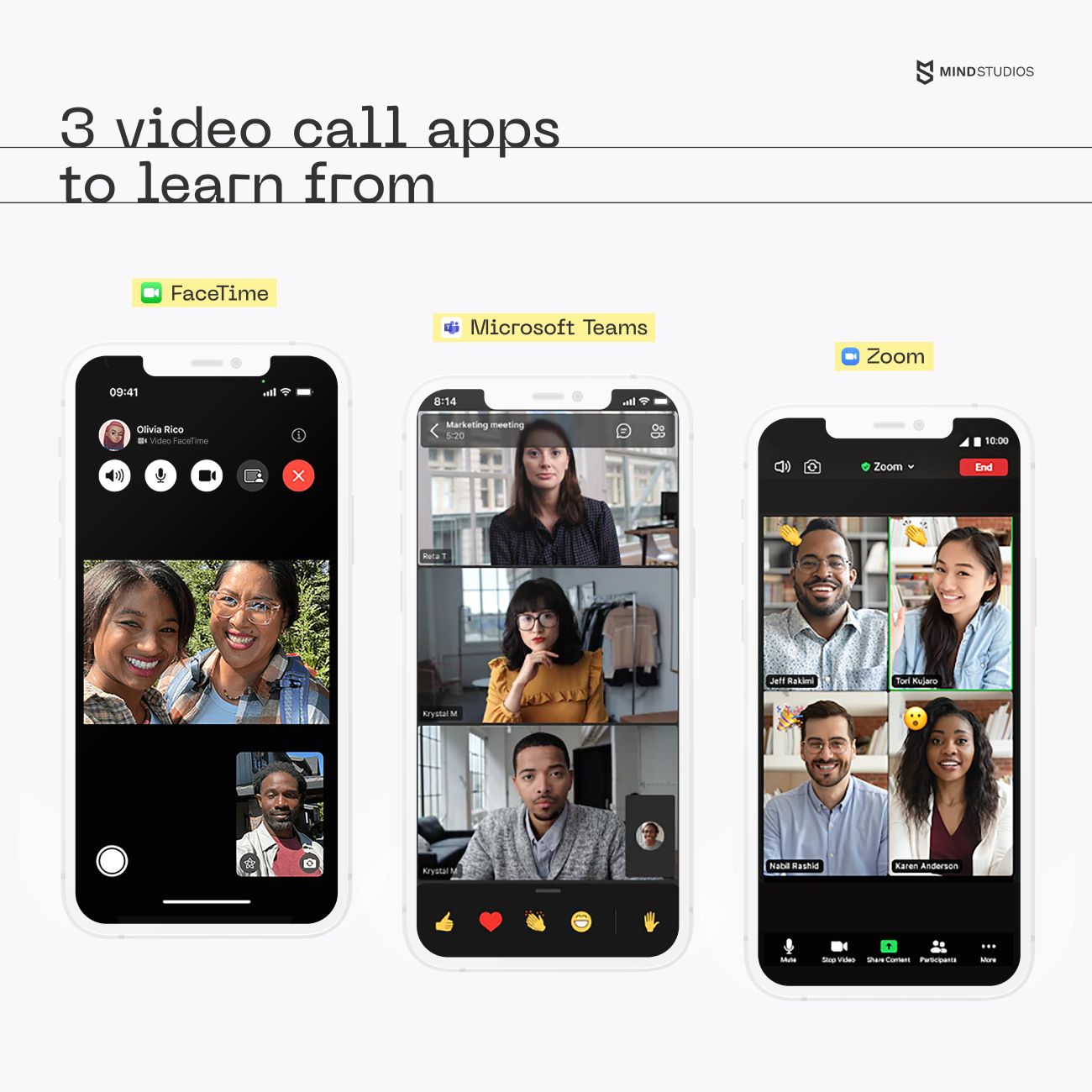
Researching and analyzing the market is an essential step at the beginning of your video call app development journey. Exploring your competitors can help you learn from their best practices and avoid common mistakes. Here, we’ve gathered some of the most popular video call applications to learn from.
Zoom
The extensive feature set and availability on all platforms (iOS, Android, and web) have made Zoom one of the most favorite platforms during the pandemic (even though it later resulted in a new term “Zoom fatigue”).
Among Zoom’s most useful features are screen sharing, real-time whiteboard collaboration, and live annotations. While it’s possible to use Zoom for free, meetings for three and more people have a 40-minute time limit. To get access to unlimited conferences for up to 100 people, you will need to buy a subscription.
Back in 2020, Zoom users experience security issues. However, the platform solved them and implemented end-to-end encryption, as well as updated its privacy policy. This has set a trend for video live chat app development like Zoom to be more security-oriented.
FaceTime
This video call app is preinstalled on every iPhone and Mac. To Android and Windows users, however, it’s only available through a web browser, where the features are limited. Those users can only join the calls hosted by Apple users, but not host them themselves.
What makes FaceTime popular is free video chats for up to 32 users in one call. It also offers fun and practical features, from FaceTime Audio to Animojis and various stickers. In addition, SharePlay functionality allows FaceTime users to watch and listen to various streamed content together with their friends.
Microsoft Teams
This platform is a bit similar to another Microsoft product — Skype. However, Teams is more business-oriented.
Microsoft Teams app works on both Android and iOS. The maximum number of users that can join a video meeting for free is 100. The platform has both free and paid plans. Its AI-powered tools provide a screen-sharing feature, background blur, and noise suppression to improve the quality of online meetings.
Must-have video calling app features
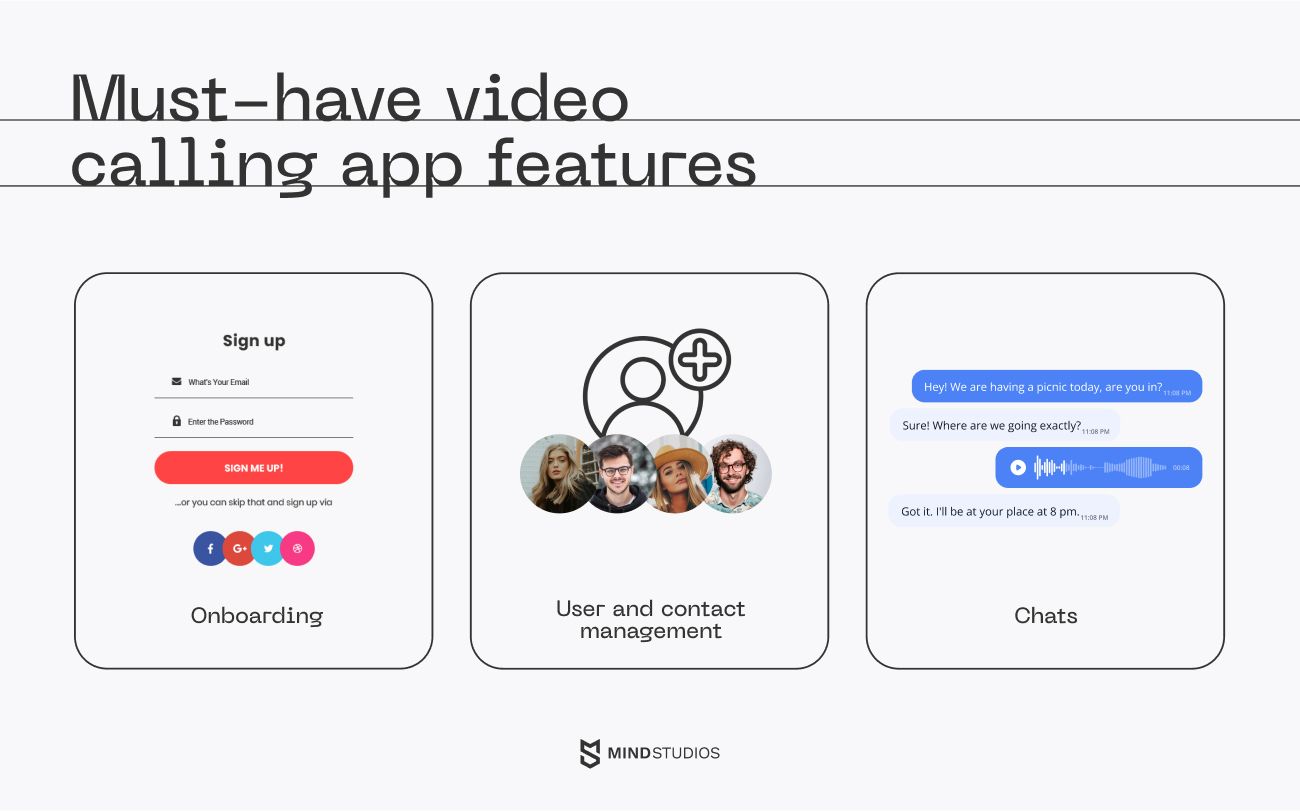
Sign-up/login
Since we’re talking about developing a video call and voice chat app — essentially, a communication tool — the onboarding process should be fast and secure. Most video call apps and messengers use phone numbers and/or email addresses for signing up. Make sure to encrypt them so they can’t be used by third parties.
User and contact management
It’s essential to allow video call app users to edit their personal information, like phone numbers, titles, and user pics, as well as manage their contact list, for instance, delete, add, and clock other users.
Chats
Of course, it’s possible to build a VoIP-only service for calls, but chances are it won’t be as popular as it could be. Text messages are important to current generations of users, sometimes more than calls. And if you’re including one-on-one texting, group chats are also expected these days.
Additionally, users expect to be able to mute chats for a set time or indefinitely so your app doesn’t disturb them when they’re busy (in a work meeting, at school, etc.).
Video calls
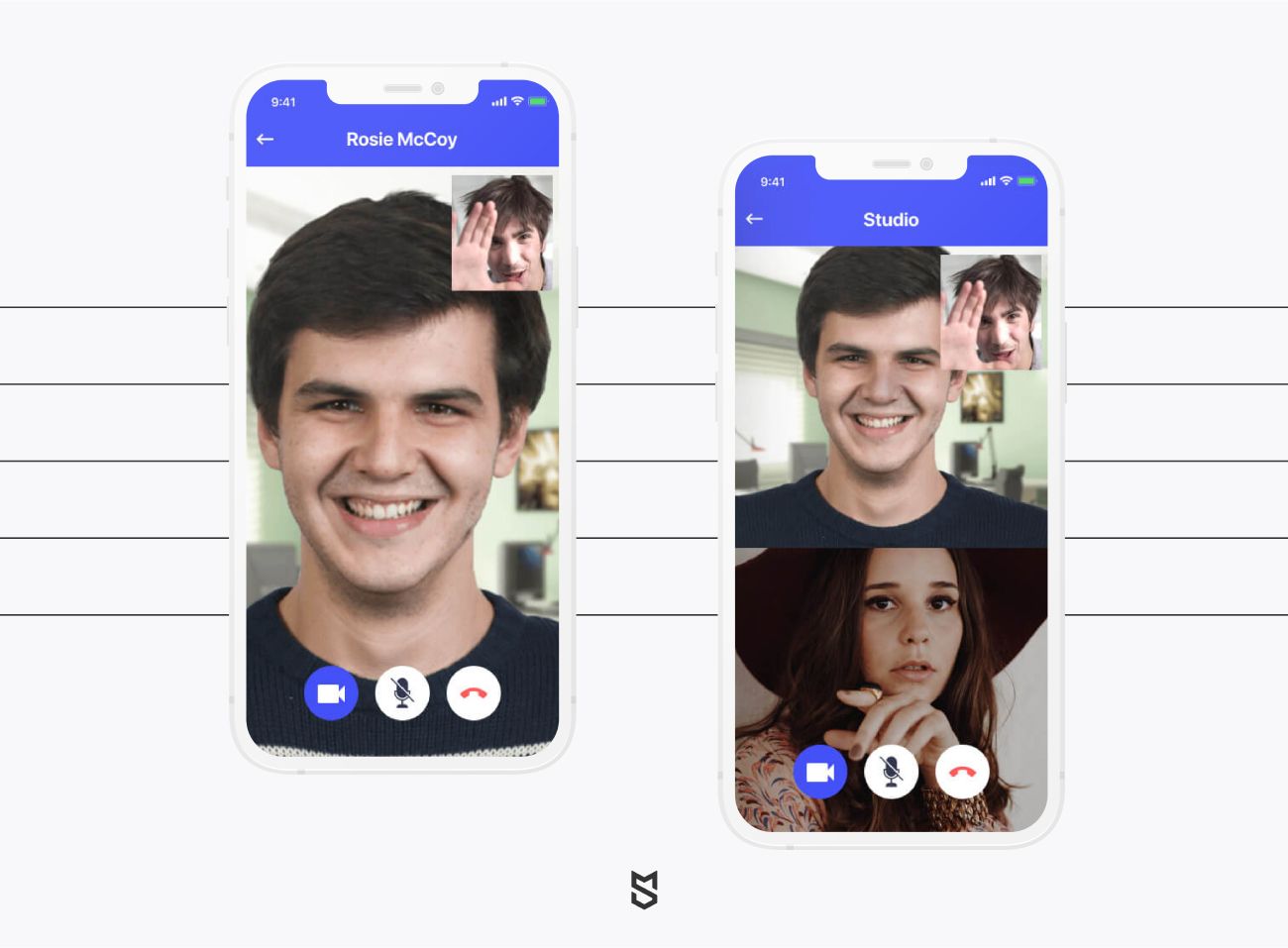
When building an app like Zoom, you need to provide group video call functionality. But even if you decide to build a video chat app for personal communication only, it’s still a sensible idea to have an option for multiple users to join in on the conversation.
Depending on the target audience’s requirements, you can add AR/VR effects, enhance the video quality, or provide in-built tools for boosting productivity during meetings.
Want to know more about VoIP app development? Read How to build a VoIP app like Discord.
Screen Sharing
Especially useful for video conferencing apps used for work, this feature allows users to share presentations, conduct onboarding and online tutorials, etc. It also increases the efficiency of business meetings and communication in general.
Audio calls
Though we focus on video chats in this article, audio calls are also a feature appreciated by users. For instance, FaceTime offers both video and audio chats.
VoIP services transmit audio using internet protocols, hence the name Voice over Internet Protocol, or VoIP. Since there are multiple VoIP services offered today, to make yours stand out, you’ll at the very least need to provide a high-quality connection. Users need to hear each other clearly, without delays and distortions.
Audio/video message recording
If your voice chat has a media-sharing feature, users can record video and audio messages outside the app and then share them in the chat. However, this isn’t the most convenient way of communicating. Instead, you can connect the app to a device’s camera and microphone so users can record and send media right in the app. This will save a lot of time and greatly improve the user experience.
Notifications
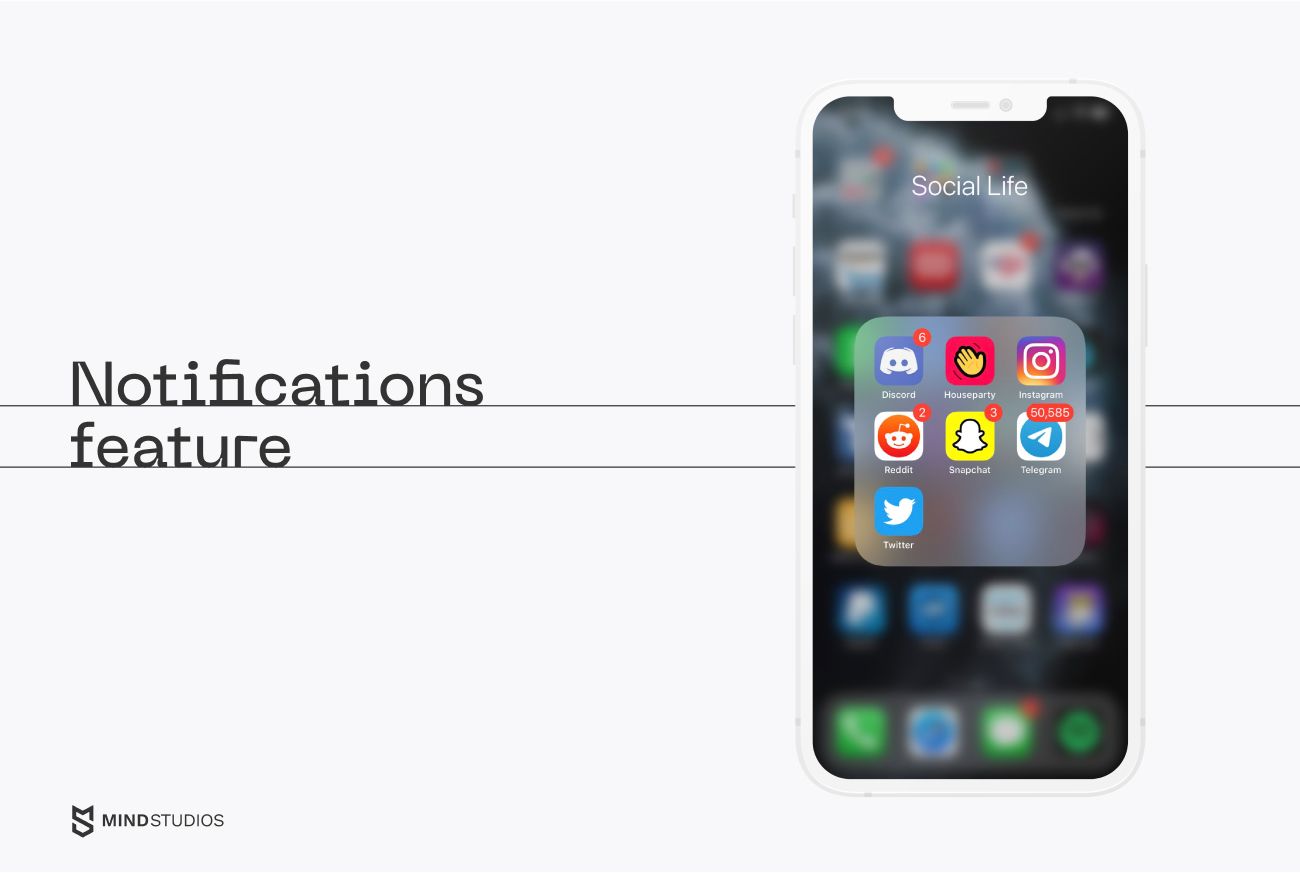
Notifications are essential so users don’t miss messages or call requests even when the app is in the background. For mobile apps, these notifications come as push notifications. They need to be customizable so users can mute the app when they’re busy. Bonus points for making notifications customizable for each chat in addition to the option to mute the app overall.
Server
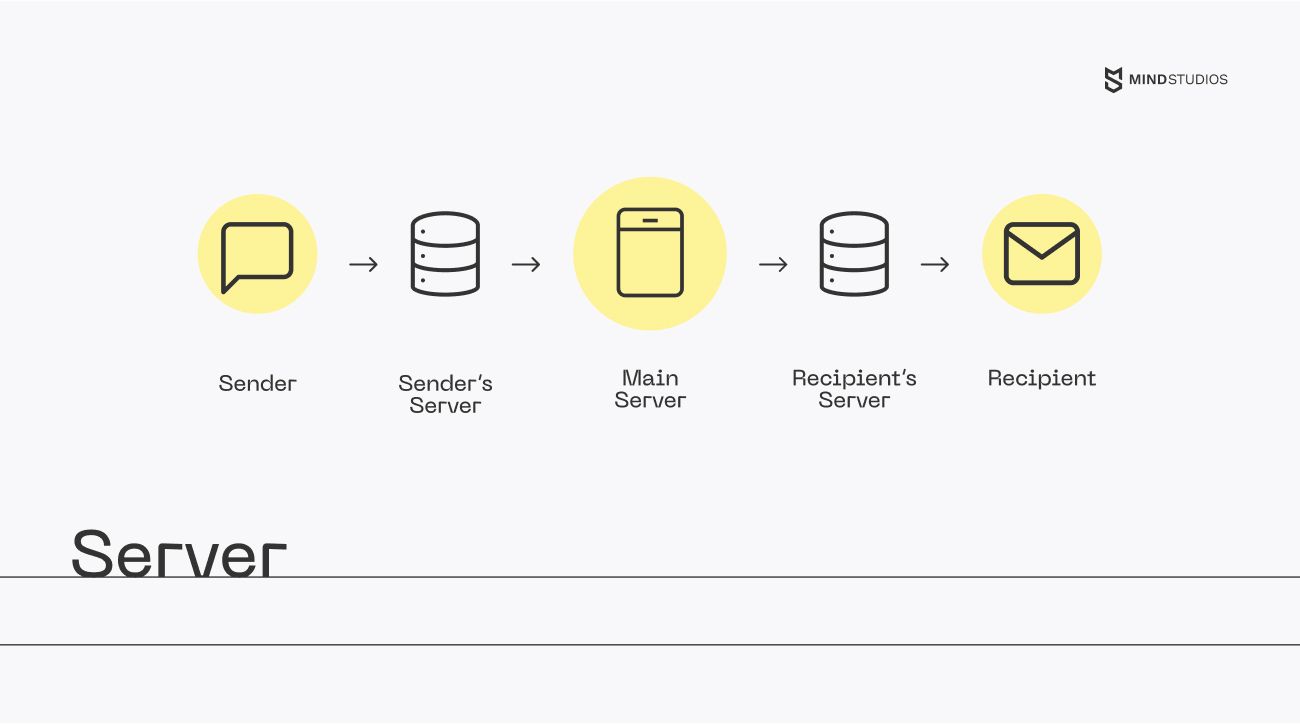
To make messaging and syncing between devices possible, you’ll need a server. You can have a physical server or a cloud-based server. It’s generally believed that cloud-based servers are more secure than physical ones, though the jury is still out on that.
Another thing you need to keep in mind when planning to make a video calling app is server capacity. It takes more processing power to stream quality audio and video than it takes to send text messages and even media. Besides, we’re talking about streaming both ways simultaneously. Without a good server, the connection can be slow and the signal might come with delays, which frustrates users to no end.
Here are some additional features that might be suitable for your video calling app, depending on its main purpose:
- @mentions to notify users in a chat in case they’re muting it or are offline, and #hashtags to find all messages on a topic in the chat history.
- Photo and video editing tools so users can tweak the media they send in the app. You can offer only basic options like crop/rotate/add text, or you can go for a big bang and introduce AI for video retouching.
- Stickers are available on most messengers offering video call features. Some, like Viber, only offer stickers drawn by their team of designers, and many of those stickers are paid. In other apps, like Telegram, you can upload your own stickers. This might be tricky with copyrights, though, so if you do that, prepare to handle occasional copyright complaints.
- Custom filters are suitable for personal and entertainment video call apps, making the experience more fun.
- Virtual noise cancellation enhances the audio quality through deep learning algorithms suppressing distracting sounds.
- Content moderation allows video call hosts to easily block or ban users sharing inappropriate content and keep the meetings safe for participants.
Some features from the list above might serve your business goal perfectly, while some might be completely inappropriate. Depending on the specific purpose of your platform, after conducting thorough research, the development team will find the tech solutions that will satisfy your audience’s needs.
How to build a video chat app: 5 best practices to follow
1. Business analysis
To develop a mobile app similar to FaceTime, you first need to conduct research. After all, there are numerous world-renowned competitors, such as Skype, Telegram, and WhatsApp. You’ll need to know the market, including specifics of the area you’re planning to target and your audience’s requirements. You’ll also need to find a unique value proposition — a feature or set of features that will help you market your product and snatch users from competitors.
If you’re planning to work with an outsourcing development company instead of separate freelance developers, you’ll most likely have a project manager and a business analyst to help you conduct the research. At Mind Studios, our project managers are also experienced in business analysis and can perform in-depth research, as well as conduct interviews with prospective users.
Business analysis alone can take two to four weeks of work, depending on the market.
2. Design, prototyping, and feedback
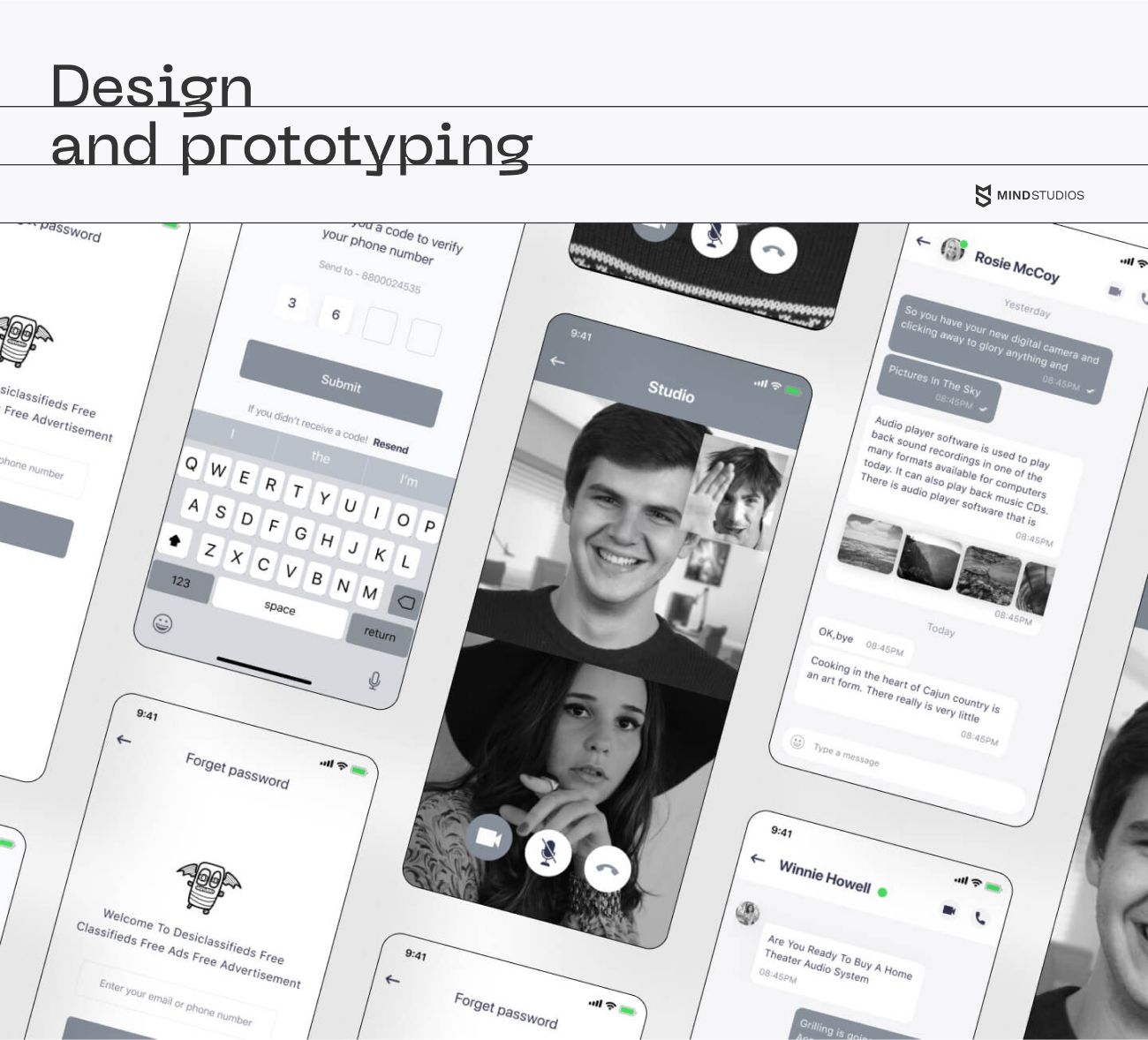
While conducting business analysis or right after it, your team should begin to create the first mockups or low-fidelity prototypes of your app. The aim of these rough sketches is to convey the logic behind the app, define the scope of work, and make sure the team and the client are on the same page.
After those are validated and approved, two more prototypes are made: a medium-fidelity prototype and a high-fidelity prototype. The first usually includes some interface design but is often black-and-white; the second can be interactive in a way to test the user experience.
To learn how to build your own video chat app and make it successful, you’ll need feedback from your target audience. At the earliest stages, before you have a functional app you can release to the public, you’ll need a test group selected based on research into your target audience.
By receiving feedback on prototypes from a test group, your developers can make changes to the app’s design and features. This makes video conferencing app development more on point, increasing the chances of a successful launch.
3. Minimum viable product
A minimum viable product (MVP) is a functional yet incomplete product. This is the first version of your app you can release to an app store. The MVP is focused on basic functionality and often pays fairly little attention to visuals or the user interface. In short, an MVP is an app with basic necessary features but without much in the way of attractiveness. It works to test the functionality, though.
An alternative to an MVP is an MLP — a minimum lovable product. An MLP will also provide very basic video call and voice chat functionality but will have a more refined interface design than an MVP. This is done to engage users and build an emotional attachment to the app.
An MVP is a version of an app that can already be monetized in some way. This helps you obtain some return on investment, adding to your development budget.
You may engage in several attempts at an MVP/MLP before you and your development team reach a version of the app that’s marketable. After that, you can add more features and further improve the design.
4. Data security
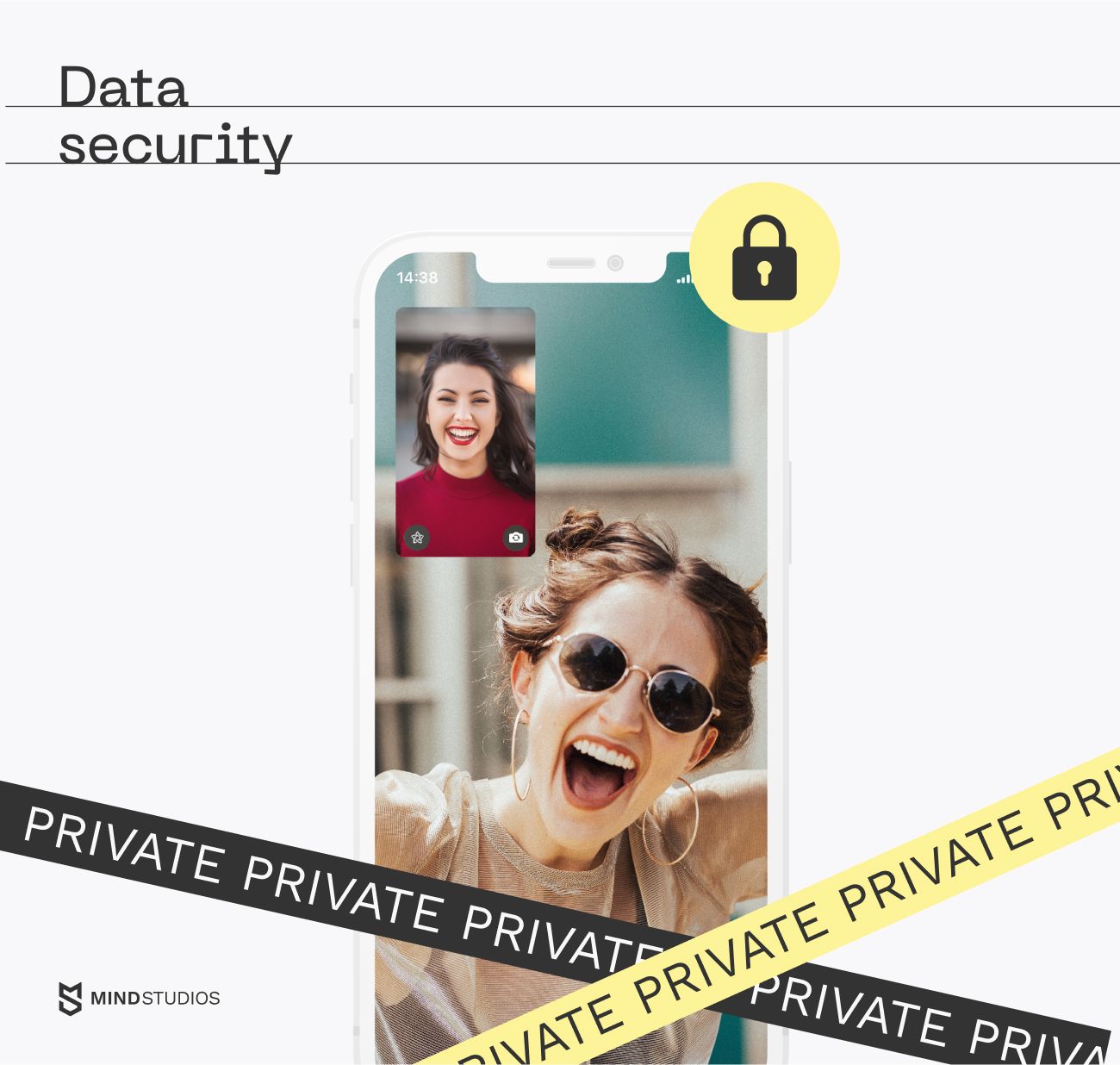
The biggest and most important part of tackling video call and voice chat app development like FaceTime or Zoom is data security. Messengers contain a lot of personal information. This includes users’ phone numbers to which accounts are usually bound and all the information people share in messages. Such data must be encrypted for your app to be allowed on the market.
One of the safest encryption technologies used in messengers is end-to-end encryption, where messages are encrypted before they leave the sender’s device. This way, messages can only be decrypted by the sender and the recipient. No one in between, not even the app owner, has the decryption key. Thanks to this technology, it’s become harder to hack messages users send each other.
Hence, when you decide to build a video conferencing app, you need to hire developers with experience in the latest security technology. At Mind Studios, we have experience working on a messenger app with the highest possible level of data protection, and we keep up with the latest developments.
5. Tech stack
The choice of technology for video chat app development directly influences how smoothly it’s going to work, as well as how secure and well-trusted it will be for users. Here is what the tech stack for a video calling app like FaceTime might look like if built by Mind Studios’ mobile app developers:
| Technology stack for a video calling app | |
|---|---|
| Mobile platforms | Android, iOS |
| Programming language | Kotlin for Android, SwiftUI for iOS |
| Frameworks | Ruby on Rails, Node.js, Phoenix (Elixir) |
| Databases | PostgreSQL, MySQL, MongoDB, Firebase |
| Cloud platforms | Google Cloud, AWS, Azure Cloud |
| API and SDK | Twilio |
| Streaming protocols | WebRTC |
| Push notifications | APNs, Firebase Messaging |
Cost to develop a mobile app like FaceTime
Video call app development is a lengthy and complicated process. We can’t offer a definitive estimate without discussing what exactly you’d like to create. The number and complexity of features you want to have in your app, the time frame for development, the number of specialists you’re ready to hire, and even the location of your developers will all affect the final cost.
However, we can provide you with a very rough estimate based on the features we’ve laid out above and the work of the following team at Mind Studios:
- 1 project manager
- 1 UI/UX designer
- 1-2 Android developers
- 1-2 iOS developers
- 1 backend developer
- 1 QA engineer
This is a minimum team needed to create your own video chat app like FaceTime. If you decide to build an app for iOS or Android only, you can forgo one developer. However, our experience says that with messenger apps for the general public, it’s usually better to offer versions for both platforms.
For the team we’ve listed, it would take about 5 to 7 months to launch an audio and video calling app MVP with the features mentioned above. Here is a more detailed time and cost estimate for each of the development stages. The calculations below are based on a $45 hourly rate.
| Stage | Time (hours) | Cost (USD) |
|---|---|---|
| Discovery stage | 100 | 4,500 |
| UI/UX design | 220 | 9,900 |
| Android development | 1180 | 53,100 |
| iOS development | 1120 | 50,400 |
| Back end + admin panel | 840 | 37,800 |
| Quality assurance & project management | 590 | 26,550 |
| Total | 4,050 | 182,250 |
After the MVP launch, the time and cost for finishing the project will depend on the response from your target audience and the market situation. In the best-case scenario, a full app could be ready in ten months. Faster if you hire extra developers or cut some features.
Keep in mind that this estimate for the cost to develop an app like FaceTime is very approximate. For more precise numbers, you’ll need to discuss the details of your project with the team you’re planning to hire.
Using web services (builders) to create video chat apps
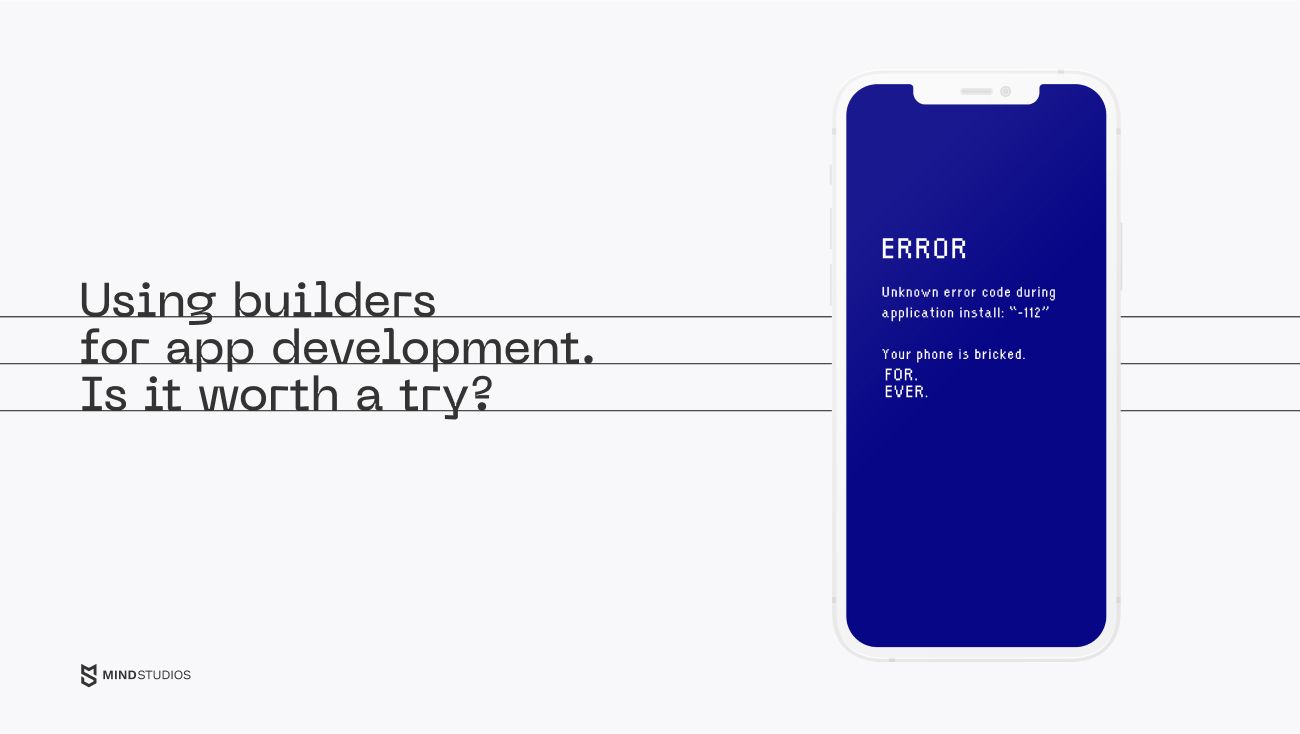
So, if you want to create a video calling app, you probably have looked into software builders. Web- and app-builders often look like a tempting way to significantly reduce development costs. After all, creating an application with a constructor doesn’t require programming skills, and therefore, frees you from the necessity of hiring an entire development team. However, such ready-made solutions typically come with certain limitations and drawbacks. Here are the most substantial ones:
-
Limited features
While app builders allow you to add basic features needed for video calls, your platform will likely turn out to be just another clone of the existing apps. The functionality and design available on such constructors are limited and rarely allow implementing the unique vision you have for the app.What is more, applications created with the help of app constructors are based on pre-developed templates. Therefore, if you start off with a basic version of the app, it would be hard to scale it later, since app builders provide next to no opportunities for updates.
-
Non-responsive design
This is a pretty common disadvantage of ready-made solutions, meaning the app might not work as flawlessly on all mobile devices as it would if developed by a skilled team. -
No chance of implementing advanced technologies
Let’s say, you want your video chat app to be unique and ready to compete with the big players on the market. To achieve this, you will most likely need to take into consideration such tech trends as AI, VR, advanced analytics, and gamification.However, usually, builders do not include these solutions in their templates — simply because it would be too complicated. Therefore, if you plan to build a revolutionary product, custom development is the only way to go.
-
Limited support options
Most development teams, including Mind Studios, don’t cut ties with their clients once the app is launched. Continuous technical support, maintenance, and updates are part of the deal when working with professionals. And that is simply not the case with app builders. If any problems occur, you will most likely have to find a specialist to fix them by yourself. -
Less control
While app builders don’t require you to know how to code, they also don’t give you ownership over the code created. So, while the product technically belongs to you, the code belongs to the app builder owners, thus meaning you have less control over the app. If there are any bugs, you will have to rely on support and maintenance services from the app builder side, and that might not be as quick as you hope.
Unfortunately, it’s impossible to make your own video calling app that offers top-notch quality and unique features without spending a dime. However, there are ways to reduce costs for app development, including starting off with an MVP and outsourcing the project to a team from a region with moderate hourly rates.
How Mind Studios can help you develop a video chat app
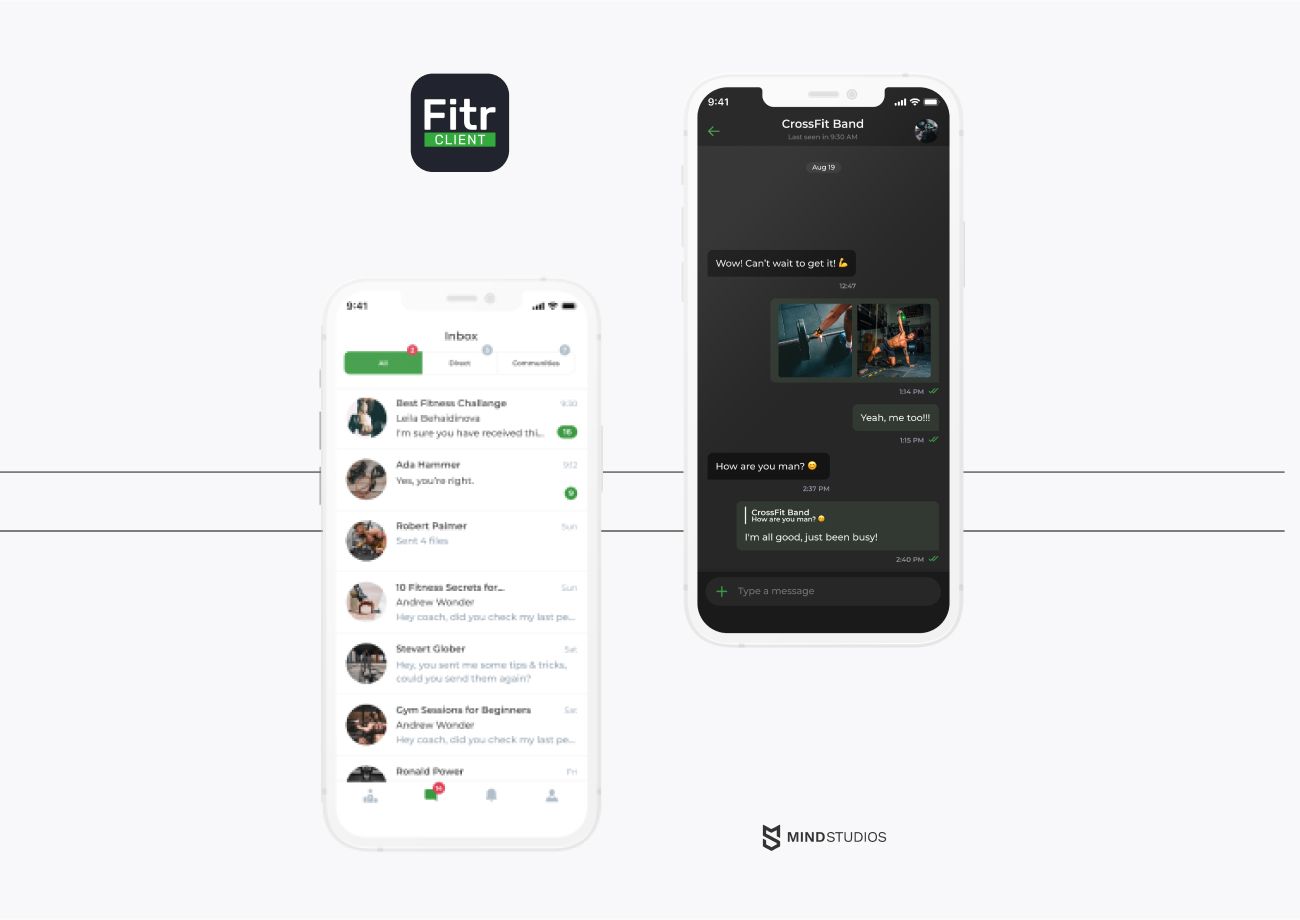
Connecting people through technology is at the center of multiple Mind Studios’ projects. In the list below, you can get acquainted with the projects where our development team got to implement communication features like chats and video sharing:
- Secure messenger created specifically for the Middle East region. While security here was priority number one, we also wanted to assist users with maintaining a healthy life-work balance. Since our target audience was mainly young working professionals, we built a system of flexible notifications and created two modes: for work and personal communication.
- Fitr, a remote coaching platform. Built for both web and mobile use, this platform allows fitness coaches to conduct video training sessions for athletes from all over the world. Naturally, Fitr also enables communication and information sharing between coaches and their clients through personal and group chats.
- SternFit, a social network for athletes. This project started off as a platform for people to share their exercise and dietary programs. However, it grew into a social application, uniting people interested in sports and healthy lifestyle, and giving them a sense of community.
With the app development experience we have, there is one thing we can say for sure. The idea of blindly duplicating an app — whether it’s Zoom, FaceTime, or Bunch — doesn’t make much sense and won’t lead you anywhere. However, with proper research of the market and the needs of your target audience, it’s possible to find the right niche and make a video call app that is unlike any other platform out there.
Conclusion
Continuous adoption of remote and hybrid work, distance learning, online dating, and telemedicine, as well as globalization in general, are just a few drivers of the video calling app market growth.
By 2027, the mobile VoIP Market is expected to reach USD 58.21 Billion, meaning it will be expanding at a 12.2% compound annual growth rate. So, if you have ideas for a video chat app, now is the best time to think about joining this market with an app of your own.
Mind Studios is an experienced chat app evelopment company with seasoned professionals who keep their eyes open for new technologies and trends. We also offer not just development but consulting services.
If you have a messenger idea in mind — drop us a line via our contact form. Our team will be happy to arrange a free consultation for you and answer any questions you have about how to make a video chat app.

